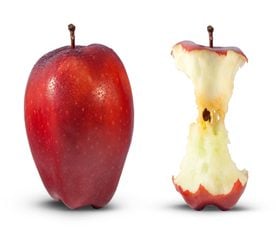Growing Apples: Problem Signs and Symptoms to Watch for
The majority of apple pests can be controlled with one dormant spray plus the controls specified in the chart, if the pest is identified. The dormant spray goes on just as buds open. When applying sprays in the spring, avoid spraying at times when pollinating insects are present. Applying a repellent garlic extract spray may deter apple pests overall.

| SYMPTOMS AND SIGNS | CAUSE | CONTROL |
|---|---|---|
| Leaves curled (sometimes flushed with red); shoots may be distorted. Many sticky insects present. | Aphids (greenfly or several other kinds) | Apply a dormant oil spray just after bud break to kill eggs. Apply insecticidal soap just before bloom. Repeat after blossoming if necessary. |
| Apples have small skin blemishes. Inside, mature fruits show corky brown streaks; maggots (“worms”) visible. | Apple maggots (fly larvae) | Pick up and dispose of fallen fruit daily. Hang red sticky ball traps in trees. |
| Young fruits have small brown holes in skin, often with brown ribbonlike scars leading from them. Unpleasant odor present when fruits are cut open; “worms” visible. | Apple sawflies (larvae) | Hang white sticky cards in trees at blossom time and remove them at petal fall. Spray with neem immediately after petal fall. Apply parasitic nematodes to the soil beneath the trees shortly after petal fall. |
| From midsummer on fruits bear small holes; no associated scar. No noticeable odor when fruits are cut open. White caterpillars feed inside fruits. | Codling moths (larvae) | Hang traps in trees to catch male moths. Spray Bacillus thuringiensis about 2 wk. after petal fall starts, then apply two more sprays, 5 days apart. |
| Leaves finely mottled, turning yellow or rusty brown. | Two- spotted, or red spider, mites |
Spray with insecticidal soap in early summer. Repeat if necessary. Plant ground covers to attract mite predators. |
| Eggs, deposited on twigs, hatch when flowers are deep pink. Larvae (caterpillars) chew foliage. | Leaf rollers or leaftiers (moth larvae) |
Apply Bacillus thuringiensis at pink bud stage; spray again at petal fall if pests are still present. |
| SYMPTOMS AND SIGNS | CAUSE | CONTROL |
|---|---|---|
| Curculios puncture and lay eggs in very young fruits, leaving crescent-shaped scar. After eggs hatch, larvae (grubs) feed inside apples, causing premature drop. | Plum curculios (weevils) | Collect fruit as it drops. When petals fall, spread a sheet below the tree and hit the tree trunk with a padded stick; collect and destroy the curculios daily for 3 wk. Also, apply horticultural kaolin clay at petal fall and then weekly for 6 to 8 wk. |
| Rough, scaly deposits (white, gray, or brownish) occur on twigs, bark, and fruits. Juices are sucked from trees, causing reduced growth and yellowed leaves. | Scale insects (San Jose, oyster shell, scurfy scale, or others) | Spray with dormant oil at bud break. Summer oil can be sprayed as contact control in late spring when new scales (“crawlers”) appear. |
| Leaves and young stems distorted, covered with white powder. Premature leaf fall may occur. | Apple powdery mildew (fungus) | In late spring and early fall spray regularly with wettable sulfur. |
| Brown or blackish scabs on fruits, leaves, and shoots. When scabs have coalesced, they may become corky. | Apple scab (fungus) | From the time bud scales fall to midsummer, spray with sulfur. When pruning, cut out and destroy diseased parts. |
| Leaves turn brown and look burned, hang down from the branch, but do not fall. Cankers arise on branches. |
Fire blight (fungus) |
Prune out infected branches when seen. Spray with lime sulfur in late winter and with a copper fungicide as leaves unfurl. |
| In early summer foliage has orange rusty spots, which become dark orange, crusty, and scabby. Fruits may show sunken areas or orange spots; generally unsightly. | Rust (cedar- apple or hawthorn) |
Eliminate all red cedars (Juniperus) within 750-m radius. Cut off overwintering fungal galls on cedars. Spray with copper fungicide when flower buds show pink. Repeat at blossom time, again at petal fall, again 10 days later, and twice more. |
| Skin is pitted and flesh has brown flecks and tastes bitter. | Bitter pit (nutritional imbalance) | Generally caused by a lack of calcium in the soil, but other minerals may also be involved. Mulch heavily and water during droughts. |
Originally Published: March 20, 2012



